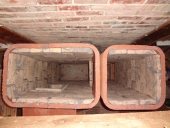
 4
4




 3
3





 4
4




For all your Montana Masonry Heater parts (also known as) Rocket Mass heater parts.
Visit me at
dragontechrmh.com Once you go brick you will never go back!

 6
6




thomas rubino wrote:
In this case, you want that heat to travel upstairs and not create a super warm basement.
How Permies works: https://permies.com/wiki/34193/permies-works-links-threads
My projects on Skye: The tree field, Growing and landracing, perennial polycultures, "Don't dream it - be it! "
 4
4




thomas rubino wrote:A single bell will share its heat sooner, but will also lose that heat more quickly than a double skin.
thomas rubino wrote:If you have headroom concerns, the roof of your bell can be insulated to limit how hot the bell roof can get.
You should use an insulator between your home and the neighboring house or any outside wall the bell is close to.
thomas rubino wrote:There is a limit to just how much ISA can be maintained hot to keep a steady draw up your chimney.
thomas rubino wrote:Heating an old Victorian house is a big job for any wood burner.
Hopefully, your home is modernized with better insulation and double-pane windows.
 6
6




 5
5




 2
2




Glenn Herbert wrote:An 8" batch box is a beast, and while it may well be what you need to heat most of your house, it will need a significantly large ISA to harvest the heat. Otherwise you will just get a very hot exhaust, throwing much of the heat away. Per the sizing table at batchrocket.eu, an 8" system wants 9.4 m2 ISA in the bell.
I don't know if this is possible in your situation, but it has been done to have essentially a two story bell, with the space open through the floor so there can be heated mass at first floor level. Another option would be to have the flue from the lower floor bell feed into a second bell at the upper level.
Fox James wrote:However I do believe there may be sone leeway when building Masonry stoves if they are independently designed and specified by a heating engineer.

 4
4








Glenn Herbert wrote:I suspect the internal volume you will have in that one thin bell will make it difficult to get enough coil to absorb enough heat from an 8" batch box. A bell in the existing chimney breast space on the upper floor would occupy little room and be much safer than lots of water coil in the first very hot bell.

 1
1








Glenn Herbert wrote:The copper coil will be thin enough that conductivity will not matter much. The water flowing and keeping at least part of it cooler will be more significant. I still don't think it would approach enough absorption to equal up to 9+ m2.
If the ISA is much less than the optimum in the table, it will just not absorb all the heat you have generated and send the rest up the chimney. If your space is that constrained, I would go with a 7" batch box. This will come closer to balancing heat generation and absorption.
 1
1





 2
2




 2
2




M Ahmed wrote:
Glenn Herbert wrote:The copper coil will be thin enough that conductivity will not matter much. The water flowing and keeping at least part of it cooler will be more significant. I still don't think it would approach enough absorption to equal up to 9+ m2.
If the ISA is much less than the optimum in the table, it will just not absorb all the heat you have generated and send the rest up the chimney. If your space is that constrained, I would go with a 7" batch box. This will come closer to balancing heat generation and absorption.
Thanks buddy
I am prepared to drop down to 7 inch if required.
What if I put some bricks standing up on the floor of the bell to increase absorptive surface area?
if my calculations are correct... if I have 40 brick upstands, that will fill give me a total ISA of 9.4 sq m.
Alternatively, I could have 74 bricks sticking out horizontally on the inside of the bell wall, acting as fins. This will also fill the deficit to give a total ISA of 9.4 sq m.
Could this work? Any drawbacks to this system?
I have a question about maximum and minimums. Correct me if I'm wrong but isn't ISA 9.4 sq m (CSA x 300) a maximum? What is the minimum?
Thanks again
M

|
We don't have time to be charming! Quick, read this tiny ad:
Learn Permaculture through a little hard work
https://wheaton-labs.com/bootcamp
|




